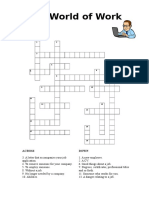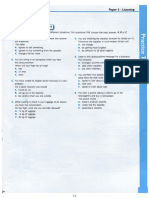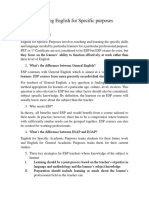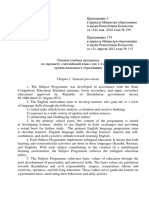0 ratings0% found this document useful (0 votes)
87 viewsEsp - Marketing
Esp - Marketing
Uploaded by
Jaenal MutaqinThe document provides details about the target audience, aims, content, methodology, and other criteria for marketing English language learning materials. The materials are intended for intermediate to upper-intermediate learners studying or working in marketing, including students, teachers, and self-learners. Each two-page unit combines explanations of marketing vocabulary on the left with a variety of exercises on the right to develop reading, writing, and language skills through authentic texts. The content is organized progressively from easier to more difficult topics within and across the 10 sections of the book. Learning draws on cognitive, affective, and practical theories and aims to develop the specialized vocabulary needed for a marketing career or business ownership.
Copyright:
© All Rights Reserved
Available Formats
Download as DOCX, PDF, TXT or read online from Scribd
Esp - Marketing
Esp - Marketing
Uploaded by
Jaenal Mutaqin0 ratings0% found this document useful (0 votes)
87 views4 pagesThe document provides details about the target audience, aims, content, methodology, and other criteria for marketing English language learning materials. The materials are intended for intermediate to upper-intermediate learners studying or working in marketing, including students, teachers, and self-learners. Each two-page unit combines explanations of marketing vocabulary on the left with a variety of exercises on the right to develop reading, writing, and language skills through authentic texts. The content is organized progressively from easier to more difficult topics within and across the 10 sections of the book. Learning draws on cognitive, affective, and practical theories and aims to develop the specialized vocabulary needed for a marketing career or business ownership.
Original Description:
Esp - Marketing
Copyright
© © All Rights Reserved
Available Formats
DOCX, PDF, TXT or read online from Scribd
Share this document
Did you find this document useful?
Is this content inappropriate?
The document provides details about the target audience, aims, content, methodology, and other criteria for marketing English language learning materials. The materials are intended for intermediate to upper-intermediate learners studying or working in marketing, including students, teachers, and self-learners. Each two-page unit combines explanations of marketing vocabulary on the left with a variety of exercises on the right to develop reading, writing, and language skills through authentic texts. The content is organized progressively from easier to more difficult topics within and across the 10 sections of the book. Learning draws on cognitive, affective, and practical theories and aims to develop the specialized vocabulary needed for a marketing career or business ownership.
Copyright:
© All Rights Reserved
Available Formats
Download as DOCX, PDF, TXT or read online from Scribd
Download as docx, pdf, or txt
0 ratings0% found this document useful (0 votes)
87 views4 pagesEsp - Marketing
Esp - Marketing
Uploaded by
Jaenal MutaqinThe document provides details about the target audience, aims, content, methodology, and other criteria for marketing English language learning materials. The materials are intended for intermediate to upper-intermediate learners studying or working in marketing, including students, teachers, and self-learners. Each two-page unit combines explanations of marketing vocabulary on the left with a variety of exercises on the right to develop reading, writing, and language skills through authentic texts. The content is organized progressively from easier to more difficult topics within and across the 10 sections of the book. Learning draws on cognitive, affective, and practical theories and aims to develop the specialized vocabulary needed for a marketing career or business ownership.
Copyright:
© All Rights Reserved
Available Formats
Download as DOCX, PDF, TXT or read online from Scribd
Download as docx, pdf, or txt
You are on page 1of 4
AUDIENCE
1. Who are the learners? Who is the material intended for?
Those who work in marketing and need to use English,
The handbook is for students, teachers, and people who have interest in it.
For public need, common reader who have interest in marketing..
The level of the book is intermediate to upper intermediate learners.
AIMS
2. What are the aims of the materials?
To help the reader to master marketing, they are who studying marketing, or teaching marketing
subject, or preparing for exams in English.
Provide the students and teachers with exercises about marketing.
Using the book for self-study or with teacher in the classroom, one on one or in group
CONTENT
3. What kind of language description do you require? What type(s) of linguistic description are used in the
materials?
- The language description required is the combination of structural, discourse-based, functional.
- The materials mostly use the combination of functional, structural, and discourse-based. In every unit,
the writers use authentic sources. So, it is suitable for they who learn about marketing.
4. What language point should be covered? What language points do the materials covers?
The materials have focus in building and improving the vocabulary uses in marketing terms, words used by
professionals, and English words with a special meaning in marketing.
5. What proportion of work on each macro-skill is desired? Should there be skills-integrated work? What is the
proportion of work on each skill? Is there skills integrated work?
The four macro-skills are needed to master the marketing field. Anyone who works in marketing field,
usually meet people from all around the world. The professionals demanded able to speak in English fluently
and know many about the marketing terminology, and able to write about marketing in English words.
Reading and listening skills are needed too, especially when we have to collect data or in negotiation
situation and condition.
The proportion of work in the book is more about reading the topic (the left hand page) and writing tasks to
improve the English vocabulary in marketing term. It is based on the teacher, if the students need improving
the other macro-skills.
6. What micro-skills do you need? What micro-skills are covered the material?
7. What text-types should be included? What kinds of texts are there in the materials?
The left-hand page
- Short Texts/ Explanation
- Visual Text (Diagram, table, charts, picture)
- Dialogue
- Vocabulary and expressions required
(Collocations; word combination & Register; formal and informal language)
The right-hand page
Variety of exercise (crosswords, short texts, gap fills, matching exercises and table complete)
8. What subject-matter area is required? What is the subject-matter area, assumed level of knowledge, and
any types of topics in the materials?
Subject-matter area
- Marketing and related fields
- Marketing studies
Assumed level of knowledge
- Vocational High school
- College/University
Level of language skills :
- Intermediate to upper- intermediate
Types of topics in the materials
- Marketing basics, research, product, positioning and branding, people; customers and staff, price, place,
publicity and promotion, packaging and public relations.
Treatment are the topics given
- The process of learning marketing course,
- Common marketing,
- Communication concepts (marketing mix and targeting),
- Talking and writing (core target and focus groups),
- Special meaning in marketing,
- Uses authentic sources (marketing forums, company websites, articles from the trade press, marketing
blogs, marketing presentations and case studies)
9. How should the content be organized within the course units? How is the content organized within the
units?
By subject-matter
Around language point
- The book has 50 two-page thematic unit s are divided into ten sections which cover topics.
- The left-hand page of each unit explains new words and expressions and show how the vocabulary is
used in real contexts.
- The right-hand page allows checking and developing the understanding of the new language and how it
used, through series of exercises.
- Appendices, covering examples of confusing words.
- Answer key at the back of the book.
- Over to you activities at the end of each unit.
Index
10. How should the content be organized within the course units? How is the content organized within the
units?
By a variety of patterns
To allow a clear focus on
Each unit has sections indicated by a letter usually A, B, and C & a clear title.
11. How is the content sequenced throughout the book ?
From easier to difficult
12. How is the content sequenced within a unit ?
From comprehension to practice
METHODOLOGY
13. What theories of learning should the course be based on? What theories of learning are the materials based
on?
The combination learning of Cognitive code (the learners as thinking beings), The Affective factor (the leaner
as emotional beings), and A Model of learning (provide a practical source of reference for the ESP teacher
and students)
14. What aspects of the learners’ attitudes to / expectations about learning English should the course take into
account? What attitudes to/expectations about learning English are the materials based on?
Refers to the EFL learner, the course should consider about the learners necessities, lacks and wants. Not all
of the student and fluently in English, and they also have to learn English vocabulary in Marketing field that
some of the words might have different meaning with the meaning in General English
15. What kind of exercises/tasks are needed? What kind of exercises/tasks are included in the material?
The exercises are presented in interesting way, with the writing skills in it, and focusing in vocabularies.
16. What teaching learning techniques are to be used? What teaching-learning techniques can be used with the
materials ?
17. What aids are available for use?
In subjective the aids are available use the other example Internet , laptop, specific marketing book
in objective the aids available use infocus , book , internet, laptop, or media
18. What guidance are the materials provided?
The statements of aims: the goal is to how student who want to be entrepreneurs must have Marketing
capital
List of vocabularies and language:
This page presents the key vocabulary in bold typeface for each theme or skills area the language is
introduced in a text, dialogues, diagrams, and tables , many vocabulary item are illustrated
Suggestion for further work : marketing learning will be the capital of other people who do not want to work
in a company but those who want to open a business that opens itself
in here the material will be given about how the activities to meet the needs and satisfaction of consumers
by making products, determining the price, place of sale and promoting these products to consumers
19. How flexible do the materials need to be ?
this books in specifically for high school majors or can be used for marketing college
OTHER CRITERIA
20. What price range is necessary? What is the price?
$19 which is equal to about Rp300.000,- in Indonesian currency.
21. When and in what quantities ? When and how readily can the material be obtained?
Online shop., in Amazon website. We can buy it online.
You might also like
- SAMPLE B2 Level 3-Practice Test Plus PTE General NO KEYDocument35 pagesSAMPLE B2 Level 3-Practice Test Plus PTE General NO KEYAnnNo ratings yet
- Activities and Exercises For Teaching English PronunciationDocument209 pagesActivities and Exercises For Teaching English PronunciationValerie Hautzinger100% (6)
- Market Leader 3rd Edition - Intermediate - PracDocument99 pagesMarket Leader 3rd Edition - Intermediate - PracTuyết Nhi Nguyễn ThịNo ratings yet
- Lesson Plan - Indefinite Pronouns Aug 16Document4 pagesLesson Plan - Indefinite Pronouns Aug 16aria jen05100% (4)
- BEC Vantage Writing Part 2 - Sample Task: Results of Customer SurveyDocument1 pageBEC Vantage Writing Part 2 - Sample Task: Results of Customer Surveyppyka100% (1)
- Communicative English Grammar PDFDocument2 pagesCommunicative English Grammar PDFLeeroy33% (3)
- Fourth Edition Hungarian Wordlist: English Part of Speech Pronunciation Example Sentence Hungarian File SectionDocument17 pagesFourth Edition Hungarian Wordlist: English Part of Speech Pronunciation Example Sentence Hungarian File SectionMarton HorvathNo ratings yet
- Market Leader Elementary EfB Prelim PDFDocument6 pagesMarket Leader Elementary EfB Prelim PDFelvis manuel suarez ariasNo ratings yet
- Business English Test For Pre-Intermediate Non-Native English SpeakersDocument3 pagesBusiness English Test For Pre-Intermediate Non-Native English SpeakersAlina CiobotaruNo ratings yet
- IEX ElementaryDocument25 pagesIEX ElementaryHana Knyplová100% (1)
- Phrase Bank Unit 2: Information Exchange Phrase Bank Unit 1: Business or Pleasure?Document7 pagesPhrase Bank Unit 2: Information Exchange Phrase Bank Unit 1: Business or Pleasure?Kavi kNo ratings yet
- Unit 2 Contacts Oxford 2009Document2 pagesUnit 2 Contacts Oxford 2009MarianNo ratings yet
- IC3 Corporate Finance Photocopiable Teachers NotesDocument10 pagesIC3 Corporate Finance Photocopiable Teachers NotesОля ИгнатенкоNo ratings yet
- Iex BeginnerDocument22 pagesIex BeginnerNeringa Arlauskienė100% (1)
- Test 4 PDFDocument6 pagesTest 4 PDF김No ratings yet
- Level A2 Learner Outcomes PDFDocument8 pagesLevel A2 Learner Outcomes PDFjosemauricioardilaNo ratings yet
- Language Leader Intermediate Wordpresscom 59f22e031723ddf0d08e8f89Document2 pagesLanguage Leader Intermediate Wordpresscom 59f22e031723ddf0d08e8f89Yousef BawazeirNo ratings yet
- Types of Holiday PDFDocument1 pageTypes of Holiday PDFBernardo AtaídeNo ratings yet
- Welcome To New Language LeaderDocument1 pageWelcome To New Language LeaderԳայանե ՄելքումյանNo ratings yet
- English For Marketing ExamDocument5 pagesEnglish For Marketing Examkelly.raita1538No ratings yet
- Cars and Car Parts Vocabulary EnglishDocument7 pagesCars and Car Parts Vocabulary EnglishagustinNo ratings yet
- Incompany Seced Upper Intermediate MpoDocument8 pagesIncompany Seced Upper Intermediate MpopathmotionNo ratings yet
- Success With BEC Preliminary SB - AnswersDocument142 pagesSuccess With BEC Preliminary SB - AnswersEdinburgh EnglishNo ratings yet
- LESSON 28 Articles-Indefinite and DefiniteDocument8 pagesLESSON 28 Articles-Indefinite and DefinitesachiNo ratings yet
- Business Advantage Upper-Intermediate Sample Unit - Students BookDocument8 pagesBusiness Advantage Upper-Intermediate Sample Unit - Students BookWild Billy Barker GahanNo ratings yet
- Business English Practice A1Document5 pagesBusiness English Practice A1Inglés In Touch100% (1)
- ELP Language Biography Checklists For Young Learners enDocument8 pagesELP Language Biography Checklists For Young Learners enhigginscribdNo ratings yet
- Cambridge English For The Media ActivitiesDocument10 pagesCambridge English For The Media ActivitiesԴավթաշենի Համակարգչային ԾառայություններNo ratings yet
- Impersonal Vocabulary For Academic EssaysDocument3 pagesImpersonal Vocabulary For Academic EssaysH.NNo ratings yet
- báo cáo thực tập TRỢ GIẢNGDocument23 pagesbáo cáo thực tập TRỢ GIẢNGNhi NguyễnNo ratings yet
- Longman Preparation Course For The TOEFLDocument2 pagesLongman Preparation Course For The TOEFLMiguel Angel Cortes VicedasNo ratings yet
- In Company 3.0 Elementary GlossaryDocument18 pagesIn Company 3.0 Elementary GlossaryMauricio SarmientoNo ratings yet
- Business Advantage Intermediate WorksheetsDocument16 pagesBusiness Advantage Intermediate WorksheetsBaruch BenítezNo ratings yet
- Manchurian Incident Lesson PlanDocument6 pagesManchurian Incident Lesson PlanIgor RadulovicNo ratings yet
- Business English CrosswordDocument3 pagesBusiness English Crosswordmelissa_cassidyNo ratings yet
- Written Communication - Topic 2 Letter WritingDocument31 pagesWritten Communication - Topic 2 Letter WritingAhmad Sidi100% (8)
- Managing PeoplesDocument4 pagesManaging PeoplesMegan MaddoxNo ratings yet
- Unit 1 Corporate Culture: p.7 Business WorkshopDocument2 pagesUnit 1 Corporate Culture: p.7 Business WorkshopFunda Ciftcibasi Yasar0% (1)
- Bec Vantage Speaking - TestDocument2 pagesBec Vantage Speaking - TestBaku Joaco67% (3)
- Language Leader TestDocument4 pagesLanguage Leader TestAna GalacNo ratings yet
- TRANSITIONAL Words ActivityDocument1 pageTRANSITIONAL Words ActivityellenochoamusicroomNo ratings yet
- Authorised Centre Support and Benefits BrochureDocument20 pagesAuthorised Centre Support and Benefits BrochureEugene DesavoieNo ratings yet
- Compare and Contrast These Two Pictures. in Your Description, Answer The Following QuestionsDocument1 pageCompare and Contrast These Two Pictures. in Your Description, Answer The Following QuestionsKarenza ThomasNo ratings yet
- b2 Part One Business English - Compress PDFDocument2 pagesb2 Part One Business English - Compress PDFJakub KokocińskiNo ratings yet
- VIDEO SCRIPTS Business Result - StarterDocument1 pageVIDEO SCRIPTS Business Result - StarterNeri De Souza SantanaNo ratings yet
- Word Formation (Negative Prefixes) : Un-In Dis - ImDocument2 pagesWord Formation (Negative Prefixes) : Un-In Dis - ImMonica FilimonNo ratings yet
- C5 - SalesDocument6 pagesC5 - SalesancadanicaNo ratings yet
- Unit 1 - World Tourism - EIT - Pre Intermediate PDFDocument4 pagesUnit 1 - World Tourism - EIT - Pre Intermediate PDFSeradona Altiria AlexonNo ratings yet
- Business Roles For BCN and AnswersDocument11 pagesBusiness Roles For BCN and Answersasdfasfasdfasdfasdfsdaf100% (2)
- In Company Interviews: Units 1-3: Before You WatchDocument2 pagesIn Company Interviews: Units 1-3: Before You WatchHarshith Gariga100% (1)
- Writing A Memo Teacher's Notes + AnswersDocument1 pageWriting A Memo Teacher's Notes + Answersselsel99No ratings yet
- Esp BussinessDocument8 pagesEsp BussinessDewi RoosnitasariNo ratings yet
- Unit 12 - Market Leader AdvancedDocument4 pagesUnit 12 - Market Leader AdvancedIa GioshviliNo ratings yet
- First Listening Test 4Document3 pagesFirst Listening Test 4Carles Sastre PérezNo ratings yet
- English: Version: EN00Document32 pagesEnglish: Version: EN00Sandra MuñozNo ratings yet
- 01 Introduction To B2 Legal EnglishDocument18 pages01 Introduction To B2 Legal EnglishMladen PavlovicNo ratings yet
- PPP - Unit 5 - Modal VerbsDocument7 pagesPPP - Unit 5 - Modal VerbsCARLOS ENRIQUE PAZMIÑO PINONo ratings yet
- DECA RolePlayDocument6 pagesDECA RolePlayAftab MohammedNo ratings yet
- Newspapers in the Elt Classroom: A Guide to the English Newspaper for Esl/ Efl StudentsFrom EverandNewspapers in the Elt Classroom: A Guide to the English Newspaper for Esl/ Efl StudentsRating: 2 out of 5 stars2/5 (1)
- ESP Material Evaluation Report to Mr.Quy. PHAM THI MINH HẬUDocument12 pagesESP Material Evaluation Report to Mr.Quy. PHAM THI MINH HẬUlamthienphong13No ratings yet
- Fifty Ways to Teach Business English: Tips for ESL/EFL Teachers: Fifty Ways to Teach: Tips for ESL/EFL TeachersFrom EverandFifty Ways to Teach Business English: Tips for ESL/EFL Teachers: Fifty Ways to Teach: Tips for ESL/EFL TeachersNo ratings yet
- Teaching English For Specific PurposesDocument6 pagesTeaching English For Specific PurposesMartina CantosNo ratings yet
- Components of Task Based Needs AnalysisDocument6 pagesComponents of Task Based Needs Analysisnguyenthanhhoa060922No ratings yet
- Master Studies: Economics S8 - English Course-Marketing - Professor: Nabila ElyazaleDocument2 pagesMaster Studies: Economics S8 - English Course-Marketing - Professor: Nabila ElyazaleKamalNo ratings yet
- Soal Latihan ColorsDocument3 pagesSoal Latihan ColorsJaenal MutaqinNo ratings yet
- Improving Vocabulary Using TGT (Teams Games Tournament) MethodDocument7 pagesImproving Vocabulary Using TGT (Teams Games Tournament) MethodJaenal MutaqinNo ratings yet
- PCX - Report ImasDocument11 pagesPCX - Report ImasJaenal MutaqinNo ratings yet
- Pretest SoalDocument19 pagesPretest SoalJaenal MutaqinNo ratings yet
- VN 2024Document10 pagesVN 2024llc.beniramosNo ratings yet
- Lesson Plan Demo First Meeting LUPDocument18 pagesLesson Plan Demo First Meeting LUPHelena GunawanNo ratings yet
- Late Bloomer or Language Impaired?Document133 pagesLate Bloomer or Language Impaired?Betül Özsoy TanrıkuluNo ratings yet
- Improving Students' Tenses Mastery Through Tenses Symbol Technique (TST) in Class X4 at SMA Negeri 1 PekanbaruDocument16 pagesImproving Students' Tenses Mastery Through Tenses Symbol Technique (TST) in Class X4 at SMA Negeri 1 PekanbaruAldiIm-possibLeNo ratings yet
- Morph Practice NewDocument4 pagesMorph Practice NewBùi Quang TrânNo ratings yet
- Straightforward Beg PortfolioDocument64 pagesStraightforward Beg Portfoliobarbara giachetiNo ratings yet
- PEEC - Effect of Social Media Language On Written English Among AB English StudentsDocument3 pagesPEEC - Effect of Social Media Language On Written English Among AB English StudentsRodel EstebanNo ratings yet
- English: Primary TeachersDocument16 pagesEnglish: Primary TeachersjelenaNo ratings yet
- Medical English in Italian University Courses in Sports Sciences (PDFDrive)Document20 pagesMedical English in Italian University Courses in Sports Sciences (PDFDrive)Ioana GusatuNo ratings yet
- History of Polynesian LanguagesDocument28 pagesHistory of Polynesian LanguagesSándor TóthNo ratings yet
- Code Mixing Used On Facebook Social Network by Efl Students at High School For Gifted Students Hanoi National University of Education PDFDocument73 pagesCode Mixing Used On Facebook Social Network by Efl Students at High School For Gifted Students Hanoi National University of Education PDFAnn CaoNo ratings yet
- Korean Lesson 1Document12 pagesKorean Lesson 1Ivett97100% (1)
- World Englishes Vs Standard EnglishDocument15 pagesWorld Englishes Vs Standard EnglishsabaNo ratings yet
- 179 Английский язык - 1-4 - русDocument49 pages179 Английский язык - 1-4 - русVictoria ParkNo ratings yet
- General Objective of Teaching English in Primary StageDocument26 pagesGeneral Objective of Teaching English in Primary StageAnonymous qiMLAqiNo ratings yet
- LLCERanglais CorrigeDocument6 pagesLLCERanglais CorrigeHAMROUN100% (1)
- English KSSR Year 5Document6 pagesEnglish KSSR Year 5Tan S YeeNo ratings yet
- Professional Statement WhileDocument1 pageProfessional Statement WhileMuhammad Zul AizzatNo ratings yet
- Module 3 BSSW 2BDocument28 pagesModule 3 BSSW 2BJoseah Mae Saenz100% (1)
- Table of Topics Per Class 43-63Document2 pagesTable of Topics Per Class 43-63Marin PiqoniNo ratings yet
- AFFIXATIONDocument10 pagesAFFIXATIONHala Tawfik MakladNo ratings yet
- 10 Simple Steps To Becoming Fluent in EnglishDocument15 pages10 Simple Steps To Becoming Fluent in EnglishabdulsalamchanatNo ratings yet
- Unit K.2 Good FriendsDocument16 pagesUnit K.2 Good FriendsEdeil RiveraNo ratings yet
- PREPARE 3 Vocabulary Plus Unit 16Document2 pagesPREPARE 3 Vocabulary Plus Unit 16Ha Anh Chu NguyenNo ratings yet
- WWW - Rasbd.Tk: Hometown 8. How Long Have You Lived in Your Hometown?Document4 pagesWWW - Rasbd.Tk: Hometown 8. How Long Have You Lived in Your Hometown?gulzadaraNo ratings yet





























































































